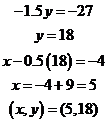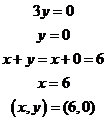Matrices are used to solve systems of equations neatly and concisely. The equation coefficients are the matrix elements, and the variables are not written. Each equation takes up one row of the matrix, usually with the coefficient of x in the first column, the coefficient of y in the second column, and so on for systems containing more than two variables. This matrix is referred to as a coefficient matrix of the system.

When the constant coefficients of the system’s equations are included in a matrix, it is called an augmented matrix. These values are always arranged on the far right of the matrix, in the same row as the equation to which they belong, usually behind a bar that separates them from the rest of the elements.
Examples |
Explanation |
 |
The coefficient matrix: |
 |
| |
The augmented matrix: |
 |
Matrices can be used to solve a system of any number of equations in any number of variables. In this lesson, however, we will concentrate on systems of two equations in two variables. This means that all of the augmented matrices we use will be 2*3 matrices: 2 rows, one for each equation and 3 columns, one each for the x,y, and constant coefficients.
Solving a system of equations using a matrix is accomplished by applying a series of elementary row operations to the augmented matrix.
Elementary Row Operations
- Swapping any two rows (Rn ↔ Rm ).
- Replacing a row by a nonzero constant multiple of itself (KRn → Rn).
- Replacing a row by the sum of a nonzero constant multiple of another row and itself (KRn+Rm → Rm).
The notation → Rm indicates that the result of the calculation will be placed in row m.
|
Explanation |
 |
Swapping two rows.
 |
|
Replacing row 2 with its double.

Replacing row 2 with the sum of -3 times row 1 and itself.

|
Reduced Row Echelon Form
To determine the solution of a system of equations from its augmented matrix, elementary row operations must be applied to the augmented matrix until it is either in echelon form or reduced echelon form.
If the system has one unique solution, an augmented matrix in echelon form will provide the value of at least one of the variables; the other variable must be determined by substituting this solution back into one of the given equations. In general, an augmented matrix in this has this appearance:

where a,b,c,d are constants. The second row represents the equation 02x+12 , or y=d. x must be determined by substitution.
The values of all variables can be read directly from an augmented matrix in reduced echelon form; no further work is required. An augmented matrix in this form generally looks like this:

Note that the coefficient matrix is the identity matrix in this form.
Examples
Express in echelon and reduced echelon form:

Explanation

This matrix is now in echelon form. Y=3.

The matrix is now in reduced echelon form. It is clear to see that x=2
Try these exercises:
Solve the following systems of equations.






Answers to questions:











